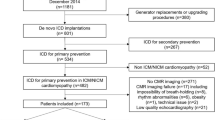Abstract
The conventional criteria for a defibrillation lead (DL) implantation don’t take into account presence of scar or deep ischemia in the myocardium. This may impair a proper functioning of the DL. We sought to optimize the DL implantation placement using rest myocardial perfusion scintigraphy (MPS), which allow detecting areas of myocardial hypoperfusion (MH). To study the influence of MH and scarring, detected by MPS, on the DL parameters in patients with coronary artery disease (CAD). 69 patients (male—65, age 64.8 ± 7.7 years) with CAD and indications for ICD implantation were enrolled. Two days before ICD implantation all patients underwent MPS at rest. Then patients were divided in 2 groups. In the 1st group DL was implanted considering MPS results: to the septal position, if the most significant MH were detected in the apical segments, and to the apical position, if MH were in the septal segments. In the 2nd group DL was implanted using the conventional approach without considering MPS results. Clinical 12 months follow-up was performed with ICD interrogation. Patients of both groups were comparable by clinical and scintigraphic parameters. In the same time, in the 1st group pacing threshold was lower (p < 0.0001) and ventricle signal amplitude was higher (p < 0.0001) comparing with the 2nd group at all control points. The presence of MH detected by MPS in the area of the DL placement worsens its parameters. The results of MPS in patients with CAD can be useful for optimization of DL placement.







Similar content being viewed by others
Abbreviations
- ICD:
-
Implantable cardioverter-defibrillator
- ATP:
-
Anti-tachycardia pacing
- SCD:
-
Sudden cardiac death
- VT:
-
Ventricular tachycardia
- VF:
-
Ventricular fibrillation
- VSA:
-
Ventricular signal amplitude
- DL:
-
Defibrillation lead
- PT:
-
Pacing threshold
- CAD:
-
Coronary artery disease
- MI:
-
Myocardial infarction
- MPS:
-
Myocardial perfusion scintigraphy
- 99mTc-MIBI:
-
99MTc-methoxy-isobutyl-isonitrile
- SPECT:
-
Single-photon emission computed tomography
- SRS:
-
Summed rest score
- AF:
-
Atrial fibrillation
- PI:
-
Pace impedance
- SI:
-
Shock impedance
- PET:
-
Positron emission tomography
References
Epstein AE, DiMarco JP, Ellenbogen KA et al (2013) 2012 ACCF/AHA/HRS Focused update incorporated into the ACCF/AHA/HRS 2008 guidelines for device-based therapy of cardiac rhythm abnormalities. J Am Coll Cardiol. https://doi.org/10.1016/j.jacc.2012.11.007
Bruggeman T, Dahlke D, Chebbo A, Neumann I (2016) Tachycardia detection in modern implantable cardioverter-defibrillators. Herzschrittmacherther Elektrophysiol. https://doi.org/10.1007/s00399-016-0499-z
Zeitler EP, Sanders GD, Singh K et al (2018) Single vs dual chamber implantable cardioverter-defibrillators or programming of implantable cardioverter-defibrillators in patients without a bradycardia pacing indication: systematic review and meta-analysis. Europace. https://doi.org/10.1093/europace/euy183
Friedman PA, Bradley D, Koestler C et al (2014) A prospective randomized trial of single- or dual chamber implantable cardioverter-defibrillators to minimize inappropriate shock risk in primary sudden cardiac death prevention. Europace. https://doi.org/10.1093/europace/euu022
Swerdlow CD, Russo AM, Degroot PJ (2007) The dilemma of ICD implant testing. Pacing Clin Electrophysiol 30(5):675–700
Wilkoff BL, Fauchier L, Stiles MK et al (2016) 2015 HRS/EHRA/APHRS/SOLAECE expert consensus statement on optimal implantable cardioverter-defibrillator programming and testing. Europace. https://doi.org/10.1093/europace/euv411
Zecchin M, Solimene F, D’Onofrio A et al (2020) Atrial signal amplitude predicts atrial high-rate episodes in implantable cardioverter defibrillator patients: Insights from a large database of remote monitoring transmissions. J Arrhythm. https://doi.org/10.1002/joa3.12319
Amoros-Figueras G, Jorge E, Alonso-Martin C et al (2018) Endocardial infarct scar recognition by myocardial electrical impedance is not influenced by changes in cardiac activation sequence. Heart Rhythm. https://doi.org/10.1016/j.hrthm.2017.11.031
Burkland DA, Ganapathy AV, John M et al (2017) Near-field impedance accurately distinguishes among pericardial, intracavitary, and anterior mediastinal position. J Cardiovasc Electrophysiol. https://doi.org/10.1111/jce.13325
Powell BD, Asirvatham SJ, Perschbacher DL et al (2012) Noise, artifact and oversensing related inappropriate ICD shock evaluation: ALTITUDE noise study. Pacing Clin Electrophysiol. https://doi.org/10.1111/j.1540-8159.2012.03407.x
Pang BJ, Joshi SB, Lui EH et al (2014) Validation of conventional fluoroscopic and ECG criteria for right ventricular pacemaker lead position using cardiac computed tomography. Pacing Clin Electrophysiol. https://doi.org/10.1111/pace.12301
Verberne HJ, Acampa W, Anagnostopoulos C et al (2015) EANM procedural guidelines for radionuclide myocardial perfusion imaging with SPECT and SPECT/CT: 2015 revision. Eur J Nucl Med Mol Imaging 42(12):1929–1940. https://doi.org/10.1007/s00259-015-3139-x
Amit G, Wang J, Connolly SJ et al (2016) Apical versus non-apical lead: is ICD lead position important for successful defibrillation? J Cardiovasc Electrophysiol. https://doi.org/10.1111/jce.12952
Bongiorni MG, Burri H, Deharo JC et al (2018) 2018 EHRA expert consensus statement on lead extraction: recommendations on definitions, endpoints, research trial design, and data collection requirements for clinical scientific studies and registries: endorsed by APHRS/HRS/LAHRS. Europace. https://doi.org/10.1093/europace/euy050
Boriani G, Merino J, Wright DJ et al (2018) Battery longevity of implantable cardioverter-defibrillators and cardiac resynchronization therapy defibrillators: technical, clinical and economic aspects: An expert review paper from EHRA. J Europace. https://doi.org/10.1093/europace/euy066
von Gunten S, Schaer BA, Yap SC et al (2016) Longevity of implantable cardioverter defibrillators: a comparison among manufacturers and over time. Europace. https://doi.org/10.1093/europace/euv296
Manolis AS, Maounis T, Koulouris S, Vassilikos V (2017) “Real life” longevity of implantable cardioverter-defibrillator devices. Clin Cardiol. https://doi.org/10.1002/clc.22729
Cao J, Gillberg JM, Swerdlow CD (2012) A fully automatic, implantable cardioverter-defibrillator algorithm to prevent inappropriate detection of ventricular tachycardia or fibrillation due to T-wave oversensing in spontaneous rhythm. Heart Rhythm. https://doi.org/10.1016/j.hrthm.2011.11.023
Wilson DG, Leventigiannis G, Barr C, Morgan JM (2016) ECG predictors of T wave oversensing in subcutaneous implantable cardioverter defibrillators. Int J Cardiol. https://doi.org/10.1016/j.ijcard.2016.06.128
Sommer A, Kronborg MB, Norgaard BL et al (2016) Multimodality imaging-guided left ventricular lead placement in cardiac resynchronization therapy: a randomized controlled trial. Eur J Heart Fail. https://doi.org/10.1002/ejhf.530
Author information
Authors and Affiliations
Corresponding author
Ethics declarations
Conflict of interests
None declared. No funds, grants, or other support was received.
Additional information
Publisher's Note
Springer Nature remains neutral with regard to jurisdictional claims in published maps and institutional affiliations.
Rights and permissions
About this article
Cite this article
Atabekov, T.A., Batalov, R.E., Sazonova, S.I. et al. How to get the optimal defibrillation lead parameters using myocardial perfusion scintigraphy in patients with coronary artery disease. Int J Cardiovasc Imaging 37, 3323–3333 (2021). https://doi.org/10.1007/s10554-021-02308-x
Received:
Accepted:
Published:
Issue Date:
DOI: https://doi.org/10.1007/s10554-021-02308-x




